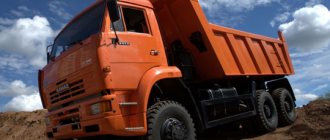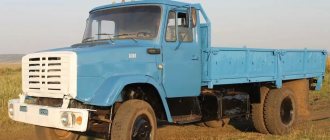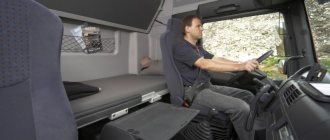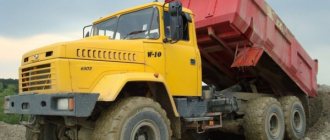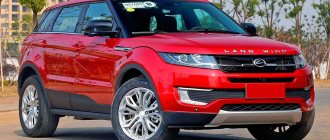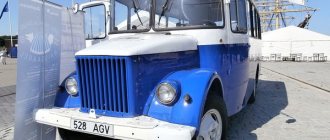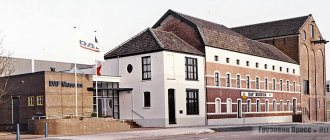ZIL-4327: technical characteristics, reviews
The ZIL-4327 all-wheel drive truck began to be produced in the early nineties of the last century. It has a mass of 9.68 tons and a carrying capacity of four thousand kilograms. In addition, the machine is capable of towing a towbar weighing up to eight tons. The vehicle is developed on the basis of modification 43360 with a wheelbase of 3.8 meters. The power unit is a carburetor engine with a capacity of 150 horsepower. The truck has several modifications that are used in the industrial, commercial and military sectors.
ZIL-157 (1958-1978)
This is a three-axle off-road truck with a 6x6 wheel arrangement, created on the basis of the ZIS-151. It was widely used in the Soviet Army, as well as in the national economy of regions with difficult natural and climatic conditions.
In 1978, production of the ZIL-157 was transferred to UAMZ (Ural Automotive Plant), at that time one of the branches of ZIL, where this vehicle was produced under the designation ZIL-157KD until 1991.
The ZIL-157, like its predecessor ZIS-151, had a complex transmission with 5 driveshafts: intermediate (between the transfer case and gearbox); to the front axle; to the middle bridge; two driveshafts with an intermediate bearing unit on the middle axle approached the rear axle. The ZIL-157 used wheels and tires of size 12.00-18.
For the first time in the Soviet automobile industry, a centralized tire pressure control system was used on a production truck. The driver, from his seat, could adjust the tire pressure of all wheels, as desired. The power of the ZIL-157 engine was 109 hp.
ZIL-157 inherited the nickname “Zakhar” from its predecessors, and it was also called differently: “Cleaver”, “Mormon”, “Crocodile”.
ZIL-4327: technical characteristics
Below are the technical plan parameters of this car:
- Length/width/height – 6.75/2.5/2.66 meters.
- Wheel formula – 4*4.
- Ground clearance - 23 centimeters.
- External turning radius – 8.6 m.
- The load capacity is four tons.
- Loading height – 1.4 meters.
- The total weight of the car is 9.68 tons (in a road train - 13.95 tons).
- The power plant is a carburetor four-stroke engine with overhead valves (liquid cooling).
- The average range is one thousand kilometers.
- The capacity of the fuel tank is two tanks of 150 liters each.
Cabin and other equipment
The workplace of the ZIL-4327 car is a three-seater cabin with two doors or a seven-seater version with four entrances (modification 4327N).
The brake mechanism includes drum blocks with a pair of internal pads and an expansion cam, which is equipped on all wheels, and has an ABS function. The electrical equipment consists of a 24 volt single wire design. The steering column is equipped with a hydraulic booster.
Regarding other main systems:
- Clutch – dry single-disc with hydraulic drive.
- The gearbox is a manual unit with a mechanical lever device for five ranges.
- The wheels are disc elements with 12.00R20 tires (tubes).
- Mechanical two-speed transfer case.
If you are wondering where the numbers are located on the ZIL-4327, pay attention to the photo below.
Peculiarities
In 2011, the truck modifications in question received an original transmission design developed at the manufacturer. Previously, axles with gearboxes from modification 131 were used. Units are produced at several plants (BAZ, Likhachev plant, Petrovsky and Ryazan branches of the plant).
The updated ZIL-4327 axles received single-stage gearboxes and greater load capacity. In addition, the cars were equipped with a symmetrical center differential lock, an increased steering angle, a new transfer case, and four-wheel drive.
The truck in question also received an improved steering mechanism, which has a hydraulic booster and better control accuracy with reduced effort during operation. As a result, the truck has become more maneuverable, more informative and more stable. Due to the use of tires from KamAZ and new rims, the load capacity has increased by one and a half tons.
Modifications
At the end of 2011, a modification of the ZIL-4327(4) truck was released, intended for the forestry industry. The machine was equipped with special winches with a gear reducer, which made it possible to obtain a large gear ratio with a relatively small weight and size.
The special and fire-fighting design was equipped with two types of winch mechanism control: a pneumatic remote controller or a mechanical lever on the winch itself.
In the winter of '12, a modification with a MAN cab was released. This example has an extended base and a reinforced front axle. The driver's seat is equipped with a personal suspension, as well as adjustment of the seat cushion and backrest. The steering mechanism is of an adjustable type with hydraulic booster.
Power unit
What kind of battery is installed on the ZIL-4327? This question is not difficult to answer - a 24-volt battery is used. The “heart” of the car of the latest modification of this series is designed for just such a battery. The engine itself is a turbine diesel engine of the MMZD-245 type, coupled with a five-speed gearbox, a two-range transfer case and a forced locking mechanism for the center differential.
All major systems can be controlled by an electro-pneumatic drive. The front and rear independent suspension is equipped with springs in the shape of a half-ellipse. The maximum speed of the truck is seventy kilometers per hour with a fuel consumption of 19 liters per hundred kilometers. The engine has a V-shaped arrangement, the cylinder diameter is one hundred millimeters, the piston stroke is 95 mm, the compression is 7.1.
Car ZIL-4327: reviews
As user responses indicate, the car in question has a good future. It has good technical parameters, versatility, good design and practicality. Owners note the truck’s good maintainability and ease of operation and maintenance.
In addition, this series is designed for a different range of work performed, ranging from the transportation of goods weighing about four tons to the transfer and transportation of special personnel and operation in the army. Unfortunately, at the moment the plant is practically not working, the production of the modification in question has been suspended, however, there are many realistic proposals in the designers' projects.
Interesting Facts
It is worth noting that a small series of specialized ZIL-4327 vehicles was used, the characteristics of which are presented above. It was planned to produce machines with attachments for the agricultural industry in nineteen ninety-eight. In addition, there were developments of trucks of this brand for public utilities (snow removal, garbage collection), fire departments and small transporters of petroleum products. In Moscow, they even created a specially designed repair shop designed to service seven-seater trucks and vans with a wheelbase of 3.8 meters.
In addition, in 2006, a type 43274N truck was created, intended for the military industry. His duties included transporting various trailers, including artillery, mortars, ammunition and equipment. There were also projects for a headquarters bus.
In conclusion
The ZIL-4327 truck had great prospects in the domestic mechanical engineering industry. The vehicle is distinguished by a universal base on which various devices can be mounted, ranging from tanks for petroleum products to agricultural equipment or military equipment.
Unfortunately, the development of this model cannot be called successful. This is largely due to great competition and times of crisis during the creation of this car. Nevertheless, the ZIL-4327 truck left a worthy mark in the history of the domestic automotive industry.
ZIL-4327
When planning to learn everything about the ZIL 4327, you should familiarize yourself in more detail with the history and features of the model. The first prototypes with an experimental design were tested in 1992-1993, but mass production of vehicles of a similar modification began somewhat later and stopped only in 2011.
This model differs significantly from its numerous predecessors in a number of parameters, which made it unique and in demand among consumers. The design was based on a model 43360 truck, which was significantly redesigned.
The 4x4 bull is equipped with an all-wheel drive wheelbase, which allows it to be used not only in conditions of poor road surface, but also in the absence of it at all. This made the modification indispensable for cargo transportation in agricultural and other fields.
If we compare the design of the vehicle with earlier analogues produced by the Likhachev Automobile Plant, significant changes can be noted. The body contours, grille, headlights, hood and other elements have been significantly redesigned to better suit modern trends.
Modifications of ZIL-4327
There are several most popular modifications of the model that are widely used. First of all, this is ZIL 4327(4), intended for use in the forestry sector. Among the main differences from most other models it is worth mentioning:
- the presence of a winch with a gear reducer;
- increased cross-country ability;
- light weight.
Often there are special versions of the car, which were also equipped with winches of various types, as well as fire engines developed on the basis of the model.
There is a separate version of the vehicle, equipped with a cabin from a foreign manufacturer MAN, which allows you to combine cross-country ability with a high level of comfort.
Technical characteristics of the dump truck
Studying the 432720 model in more detail, it should be noted that it was the performance characteristics that became the main reason for its popularity. With a small wheelbase of 3.8 meters, this unit can transport loads of up to 4 tons, which makes it the optimal solution for commercial use.
Other important technical parameters deserve mention:
- engine - turbocharged MMZD-245 diesel type, equipped with 4 cylinders. Its volume reaches 15.1 liters and its power is 108.8 hp;
- fuel tank capacity - 170 liters;
- maximum speed – 70 km/h;
- fuel consumption - 19 l/100 km;
- wheel formula - 4x4;
- curb weight - 4.85 tons.
Bus ZIL-47874A for off-road
V. Alyaev, photo by Yu. Erin
The scope of application of new modifications of Zilov off-road vehicles on the ZIL-432732 chassis is increasingly expanding. The best of the low-tonnage ZIL-5301 (“Bychka”) and the all-terrain vehicle ZIL-433420 were invested in this Russian analogue of the famous station wagons produced under the Unimog brand. The shortened and reinforced frame of the latter made it possible to accommodate a slightly modified externally “Bychka” cabin, an MMZ D-245.12 diesel engine from the Minsk Motor Plant with a power of 80 kW/108.8 hp. and a five-speed gearbox.
Most of the ZIL-4327.20 transmission units were inherited from the ZIL-131, hardened on the roads of many countries around the world. These are front and rear drive axles, driveshafts, two-speed transfer case, front suspension, wheels and much more. The system of centralized control of air pressure in tires expands the vehicle’s ability to drive both on paved roads and off-road.
The high cross-country ability of the ZIL-4327.20 has been confirmed by tests. The car confidently overcomes slopes with a steepness of 30°, roads washed out by spring floods and autumn mud, and snow drifts up to half a meter deep. Depending on the conditions of use and operation of the vehicle, two variants of the cab are provided: a standard four-seater and a two-row four-door for 7 people.
In 1999, at the Auto Show in Bulgaria (Plovdiv), at the AMO ZIL exposition, visitors showed particular interest in the plans of the plant, as well as in the prospects of creating buses for work on mountain roads on the Zilov Unimog chassis. Domestic customers, in particular the Ministry of Emergency Situations, also showed interest in such equipment.
And just recently, in accordance with the wishes of potential buyers, Zilov specialists, based on the ZIL-432732 car, created a prototype bus with 16 seats, including the driver.
The power unit on the bus is a D-245.9 diesel engine with turbocharging and intermediate air cooling. Its power is 100 kW/136 hp.
The bus body is made in the form of a modular design and is made of stamped metal panels welded together. It has four doors: two hinged cabin doors, a double-leaf glazed saloon door with an electro-pneumatic drive and a double-hinged rear emergency exit door.
The front part of the bus is almost the same as that of buses on the Bychka chassis, since part of the ZIL-5301 cab is used, which is largely unified with the ZIL-4331 cab. The driver's seat is equipped with a suspension mechanism with adjustable stiffness depending on the driver's weight. To adjust to the driver's size, the seat can be moved horizontally and vertically; in addition, the angles of the cushion and backrest can be adjusted. The conveniently located dashboard is equipped with the necessary set of instrumentation and warning lights to make the driver’s work easier. The steering wheel, equipped with a hydraulic booster, is adjustable in angle and height and ensures good maneuverability of the bus.
The high windshield with three-blade wiper and electrically heated exterior mirrors provide excellent visibility of the road. And installed halogen fog lights and new six-section rear lights provide driver comfort and increase driving safety in all weather conditions.
Next to the driver, instead of a single seat, a double passenger seat can be installed at the customer’s request. The cabin is separated from the passenger compartment by a small partition with a passage.
To ensure noise and thermal insulation, the sides of the bus are laid with non-woven artificial material up to 40 mm thick, 10 mm sheet polyethylene foam is applied to the inner surface of the roof and, finally, bitumen sheets 2 mm thick and 20 mm plywood are laid on the floor.
Passenger seats in the cabin have profiled cushions and high backrests. The upholstery is made of material duplicated with foam rubber. The interior itself is lined with the same material from the floor to the windows, and above them there are panels made of vacuum-formed ABS plastic. The ceiling inside the cabin is covered with sound-absorbing duplicated vinyl leather. The floor surface is covered with wear-resistant and hygienic material – grabiol. This is a plastic with a coating containing small abrasive inclusions, ensuring its high wear resistance. Six fluorescent lamps are used to illuminate the interior.
The cabin is heated by an independent liquid heater PZD-8, equipped with two radiators. One of them is mounted in the cabin behind the passenger seat, the second - under the rear seats of the cabin. The cabin heater is included in the engine cooling system. And one more feature of the heating system - PZD-8 can be used for pre-heating of the engine.
For ease of entry and exit of passengers, there is an additional external step.
There are cargo compartments in the lower part of the body. They house a spare wheel, tool box, and batteries.
Car device
The design of the machine provides for the presence of several elements at once, which can be considered key components. First of all, it is a means of facilitating the starting of the power unit, indispensable for diesel engines in low temperature conditions. It is installed in the intake manifold of the engine and is of the electric torch type.
Also worthy of mention:
- clutch. It is of the single-disc friction type, using peripheral springs of the pressure mechanism. Equipped with hydraulic and pneumohydraulic reinforcement;
- 6-speed manual transmission equipped with synchronizers. Has 5 forward gears and 1 reverse gear;
- steering mechanism. Equipped with a hydraulic booster, and a screw located on circulating balls is used as a working pair;
- drum brake system. Two pads are located on each wheel, and the brake drive mechanism is of the pneumatic type.
It is necessary to mention the simplest electrical equipment system used in such a vehicle model. It consists of only 1 wire with a voltage of 12 V. In addition, its important part is a 24 V starter, as well as two 12 V batteries, which serve as the main power source.
The cabin of the unit is all-metal and equipped with thermal insulation, which compares favorably with analogues in previous models. The driver's seat can be adjusted longitudinally, as can the tilt of the backrest and cushions.
ZIL-5301 “Bull” (1994-2014)
After the sharp transition of the Russian economy to a market economy in the early 1990s and the associated severe crisis, ZIL's main products - medium-tonnage gasoline trucks - ceased to be in demand. Therefore, at the beginning of 1992, the company urgently launched a project to create a compact three-ton delivery truck with maximum use of already produced components from heavier trucks (including type 4331 cabs and type 130 gearboxes).
ZIL-5301 “Bull” went into production at the end of 1994. The most suitable diesel engine for such a car turned out to be a diesel engine from the Minsk Motor Plant - a four-cylinder MMZ-245 with a volume of 4.75 liters and a power of 109 hp. This motor was considered as a temporary option, but eventually became the main one (confirming the well-known joke saying: “There is nothing more permanent than temporary”).
ZIL-5301 was equipped with an automobile modification of the tractor four-cylinder diesel engine D-245 (4750 cm³). Over the course of a decade and a half, this turbocharged diesel engine has undergone several upgrades, thanks to which its power has increased from 109 to 136 hp. pp., and the environmental class was raised from Euro-0 to Euro-3 (Euro-4 was also assumed). The Bychki were equipped with a 5-speed synchronized gearbox of the ZIL-130 type, power steering and a 3-seater cabin of the 4331 type. The tail with a shortened hood was a successful and original solution.
“Bychok” became the plant’s main hope. The number of modifications grew, but there was no huge demand for these cars. Drivers complained about poorly selected transmission gear ratios, poor workmanship, and vibrations from the engine. Over time, a 136-horsepower forced Minsk engine appeared, then imported diesel units were also offered, but this did not help much.
By 2000, the share of Bychka in the total output of the Likhachev plant reached 56%, which amounted to 12.3 thousand cars. It became possible to say that this family was still able to provide the plant with the necessary capacity utilization. In the second half of the 2000s, due to the deterioration of the enterprise’s financial performance and increased competition from domestic analogues (GAZ-3310 Valdai) and foreign (primarily Korean and Chinese) brands, the number of Bychkov sold by the plant increased rapidly fall.
ZIL-4327 (1998-2011)
ZIL-4327 is an all-wheel drive truck mass-produced by the Likhachev Plant since 1998.
Perhaps one of the most mysterious cars in the entire history of the ZIL plant. There are many photographs of this model (as the captions say), which depict completely different trucks. Let's try to sort out this confusion.
Apparently, the original prototype was a regular ZIL-4331, but with a driven front axle. It even retained the dual-pitch tires on the rear axle.
Subsequently, the rear wheels received single-pitch tires, which is more logical for all-wheel drive vehicles. It was in this form that this truck was presented at many exhibitions and this is how it appeared in specialized literature, although there was no talk of any serial production.
At the same time, the new model was presented to the military, while the old cabin from the famous ZIL-131 was installed. This option even underwent field testing.
And after that, taking into account all the wishes of both civilian and military testers, the final version with the “Bull” cabin and two different bases - models 432720 and 432730 - went into production.
ZIL-432720
Short-wheelbase modification with a wheelbase of 3340 mm. The chassis version for installing special bodies and equipment is designated ZIL-432722.
ZIL-432730
Four-wheel drive truck. The differences from the ZIL-432720 model are primarily in the wheelbase extended to 4140 mm. The chassis version for installing special bodies and equipment is designated ZIL-432732.
_________________ The unscrupulous person should not be tormented by any conscience, and moreover, by all means.
ZIL-3906
The ZIL-3906 (a direct analogue of the West German Unimog) differs from the base model ZIL-432720 in having a slightly shorter wheelbase (2800mm versus 3340mm for the ZIL-432720) and the presence of a second pair of (rear) steered wheels. The main purpose of this model is to work in municipal utilities and forestry services.
High cross-country ability of vehicles is ensured by all-wheel drive on all wheels with diagonal tube tires measuring 14.00-20″ (370-508) model OI-25 or diagonal tubeless tires measuring 16.00-20″ model IYA-333, their independent torsion bar suspension, the ability to adjust the air in the tires from 0.5 to 3.2 kg/cm, wheel steering on both axles, impressive ground clearance, as well as small front and rear overhangs.
Transmission - mechanical. The design of the car includes four final drives (gear ratio 2.09) and four wheel gearboxes (gear ratio 4.27). Clutch and gearbox type ZIL-5301. The transfer case is a two-stage one with an inter-sided lockable differential. The SUV has six power take-off points.
In pursuit of the German “Unimog” (Part 2)Multi-purpose all-wheel drive vehicles AMO ZIL
V. Alexandrov, photo by the author
Part 1 Part 2
In post-Soviet times, AMO ZIL turned out to be one of the main players in this area. In 1993, in the experimental workshop of the enterprise, they proactively produced the multi-purpose vehicle "Universal-900", in the design of which they tried to combine the qualities of a car and a tractor - a short-wheel drive all-wheel drive vehicle with a cab from the production model ZIL-4331, an original hood and an onboard platform. The transmission, brakes, steering, and tire pressure regulation system were borrowed from the ZIL-131. The Belarusian tractor diesel MMZ D-243 with a power of 81 hp was used as the power plant. Tires with a well-developed tread pattern came from agricultural machinery. In front and behind there were attachments for installing agricultural equipment or plow-brush devices. The high-pressure hydraulic system provided energy to several consumers. The “station wagon,” created essentially on a voluntary basis, turned out to be outside the plans for work on advanced technology, and therefore had no future. But the experience of its construction showed that the capital’s plant is capable of starting the production of its own Unimog. This is what happened later.
Having set the goal of creating products with completely different consumer qualities, the Zilov workers effectively used the serial aggregate base. Research was carried out in two powerful design departments - the Department of Design and Experimental Work (UKER) and the Department of the Chief Designer (OGD). Each developed its own family of machines, differing in their aggregate base and specific operating conditions and areas of application. In 1996, UKER specialists presented an experimental vehicle ZIL-5301 FA, and their colleagues from OGK (former SKB V.A. Grachev) under the auspices of OJSC Vezdekhod-GVA built a prototype ZIL-390610.
The first was the result of crossing a three-ton ZIL-5301 and an all-wheel drive ZIL-131 truck, “Bychok” “shared” a cabin with a slightly modified tail, a Minsk 105-horsepower diesel engine MMZ D-245.10, a manual 5-speed gearbox and a shortened onboard platform. A significant part of the transmission units (2-speed transfer case, cardan shafts, front and rear drive axles) and chassis elements (front suspension, brake system, wheels, etc.) were inherited from the “131st”. On both sides of the reduced length and reinforced frame of the six-ton ZIL-433360, two 125-liter fuel tanks were installed; the suspension was made dependent, and the steering was equipped with a hydraulic booster. Two pairs of single-pitch drive wheels with identical front and rear tracks (1820 mm), a transfer case with a reduction gear, a centralized tire pressure control system (variation from 0.35 to 0.05 MPa), ground clearance of 330 mm and a fairly short wheelbase a base of 3300 mm ensured that the car could overcome a meter-long ford and an incline of 30°, driving on sand, wet dirt roads, half a meter of snow, etc. If this was not enough, a 5-ton cable winch mounted on the front bumper came into play. The speed capabilities of the machine from 3 to 70 km/h made it possible to use it to perform a wide range of technological and transport operations. Possibility of power take-off from the gearbox – up to 30 hp. and transfer case - up to 60 hp. ensured the operation of all kinds of equipment with mechanical and hydraulic drives.
Successful tests of the ZIL-4327 station wagon became a well-deserved reward for the capital's automakers. The 109-horsepower diesel engine MMZ D-245.12 or the D-245.9 variant with a power of 136 hp was taken as standard; the wheelbase from 3340 to 4140 mm significantly expands the scope of application of the vehicle. The advantages of the ZIL Unimogs of this series are 80...90% unification with products of existing production, which made it possible to switch to conveyor assembly of vehicles, rapid adaptation of repair personnel in fleets where ZIL trucks were previously operated, and a preferable price compared not only to imported ones, but and domestic classmates. The capital plant has developed civilian and military versions of the Unimogs: a chassis with a 3-seater or a double-row 7-seater cabin for the installation of all kinds of superstructures and specialized equipment; flatbed trucks; cars with a van body in which you can transport people, various cargoes, install equipment, mobile repair shops, laboratories, emergency situations complexes, etc. Continuing to expand the type, Muscovites in 2000 built an experimental model of the ZIL-47874A rotation bus (17 person with driver), in which the ZIL-432732 chassis was connected to the body of a ZIL-3250 small class bus. Reliable thermal insulation of the body, a liquid autonomous interior heater, an engine pre-heater and a cabin “stove” built into its cooling system allow the bus to operate in areas with cold climates.
Domestic specialized enterprises did not ignore the Zilov “station wagons”. “Pozhtekhnika” from Torzhok turned an extended ZIL chassis with a two-row four-door cab into an ATs-0.8-4 fire tanker. The crew (7 people) has at their disposal a set of fire-fighting and rescue equipment: an 800-liter tank, a 50-liter foam tank, pressure hoses, lighting fixtures, hydraulic tools, breathing equipment, etc.
The Automobile Van Factory (KAF) from the city of Shumerlya developed a van body specifically for the ZIL-4327 family, in which, if necessary, you can place a repair shop, a canteen, a diagnostic station, a laboratory, etc. Another creation of KAF was the repair and diagnostic workshop MRDP at chassis ZIL-432722 for carrying out inspection, diagnostic and adjustment work, repair and replacement of components and assemblies in the field. The most colorful element of this installation is a fixed jib crane with a lifting capacity of 1000 kg, mounted on the front bumper.
In turn, the capital city (KDM), based on the ZIL-432720, developed and manufactured the ED-246 combined road vehicle, which serves city roads and squares year-round no worse than the German Unimog. Attachments are used (snow plow, spreader with salt humidifier, front sweeper, watering and front washing units, side blade) from the German company Schmidt.
The Kozelsky Mechanical Plant offers its own version of a mobile repair workshop based on ZIL-432720. The Dormash association from Moscow actively cooperates with ZIL: ZIL-432720 is equipped with devices for maintaining roads and streets at any time of the year, and the vehicle has been modernized here. At the end of this year, a sample with all driving and steered wheels will be presented to utility workers. The rear will have the same bridge as the front, only it will have to be turned 180°. In this design, the machine will be able to work successfully in cramped yards, narrow streets, etc.
Belarusians are also trying to keep up with the Russians. The Amkodor-NTC enterprise built the Amkodor-4511 model. The basis was taken from the basic ZIL-432722 machine, which, depending on the season, can be equipped with a spreader of anti-icing agents, a rotary brush located under the frame, a snow blade, a rotary-milling snow blower, etc.
Without exaggeration, we can say that AMO ZIL managed to take a leading position in the production of multi-purpose all-wheel drive vehicles among the CIS countries. And although the ZIL-4327 series vehicles are not able to compete with German prototypes in terms of a set of indicators, they have occupied their niche, winning the sympathy of domestic customers.
ZIL-432720 version
The appearance of the prototype ZIL-390610 in 1996 demonstrated that the efforts of the specialists from KEP and, which initiated the work and provided its financing, were not in vain. Four months after the start of work, a multi-purpose vehicle was born, which became a cross-country champion among its peers. Despite the external similarity with ZIL-432720, ZIL-390610 has completely different qualities. Why be surprised if the “station wagon” is a cross between the “Bull” and the “Blue Bird” - this is how the Air Force search and rescue service nicknamed the wheeled amphibians (ZIL-4906 and ZIL-49061) that were part of the “490” complex. The symbiosis of such dissimilar models at first glance turned out to be successful. Moreover, in terms of the originality of engineering solutions, this car, in the design of which a number of inventions are implemented, is not only not inferior to its famous German relative, but in some ways even surpasses it.
If we compare the “Zilov” car with the German “Unimog”, then races on a special track revealed the complete superiority of the domestic car, which more than once pulled out the “German” who fell into the traps set by the Russian off-road. It turned out that the main rival of this “station wagon” is tracked vehicles, and the area of use is emergency rescue and repair and restoration activities, work in the oil and gas complex - in a word, where really high cross-country ability is needed. The development of the mentioned models were modifications ZIL-390612 and ZIL-390613, which had some not very significant design differences.
In 2001, using previous experience, Vezdekhod-GVA, together with the Pravdinsky Radio Relay Equipment Plant (PZRA) from the Nizhny Novgorod region, where the production of off-road vehicles was transferred with AMO ZIL, produced the first vehicle of the GVA-3848 series (ASM-4703). The sample, manufactured under an agreement with the Russian Ministry of Emergency Situations, is intended for emergency rescue operations in conditions of complete off-road conditions, forest, swampy and rugged terrain. The specific customer of the car created in accordance with the Bison project was the Rescue Means Research and Production Center. The wheelbase of this chassis, equal to 4800 mm, made it possible to accommodate a two-row 7-seater cabin and a fairly spacious cargo compartment, which was allocated for the installation of an original van body. For convenient access to emergency equipment located in special compartments and shelves, there are six curtain-type side doors and two rear hinged doors; a three-legged sliding ladder is located on top. It is expected that the family will include flatbed trucks, utility vehicles with a van body and passenger rescue vehicles (ARVs). Models with a wheelbase of 3300, 3800, 4300 and 4800 mm were built, which can be equipped with three or seven-seat cabins. The power plant used is the Minsk 109-horsepower diesel engine D-245.12 or its boosted up to 136 hp. version D-245.9. Power reserve of at least 600 km.
The logical conclusion of the efforts of the PZRA specialists was the special vehicle GVA-3848.1 to support the activities of the operational headquarters during emergency response, delivery of the operational group to the emergency site, deployment and operation of the control point during emergency rescue activities. Structurally, the vehicle is a GVA-3848.51 chassis with a wheelbase of 4800 mm, on which the body of a ZIL-3205 bus is mounted, and a cable winch is installed in front. According to customer requirements, all models of the GVA-3848 family can be transported by any type of transport, including aviation. Cars with the GVA brand turned out to be half the price of the German Unimogs.
Trying to catch up with the German prototype, domestic designers found their own original technical solutions that fully justified themselves.
ZIL-4331
- Car make: ZIL
- Country of origin: USSR
- Year of manufacture: 1986
- Body type: Truck
A modern replacement for the legendary ZIL-130 truck. Developed to special order, the “4331” models have a wide range of capabilities, but are not without their drawbacks, which everyone has. The Likhachev plant in this version presented the first diesel truck produced in Russia. The entire ZIL model range.
ZIL-164 (1957-1964)
From October 1957 to December 1964, the ZIL-164 truck was mass-produced, a product of a deep modernization of the ZIS-150. The six-cylinder carburetor engine with a displacement of 5560 cm³ developed a power of 100 hp. at 2800 rpm; torque - 33 kgf/m at 1100-1400 rpm.
ZIL-164
The ZIL-164 car and its modification ZIL-164A were the “workhorses” of most motor vehicles in the Soviet Union for many years. These were station wagons for all occasions. On their basis, specialized factories produced large quantities of vans and dump trucks, fuel tankers and other tank trucks, fire engines and truck cranes, and other types of special equipment.
Car history
Since 1962, the Likhachev Plant in Moscow has produced a truck for the national economy under the ZIL-130 brand. The truck was extremely popular and practical, but was inferior to its classmates due to high fuel consumption. At the end of the seventies, the plant began developing a more economical model with a diesel engine. Namely, in the 70s, the designers of the Likhachev plant received the task of developing two advanced trucks with different load capacities.
The models were supposed to run on diesel fuel. Initially, the car was designed by ZIL specialists, but after the design was created, the documentation was transferred to Naberezhnye Chelny. In 1986, the first ZIL-4331 began to roll off the assembly line. It was this model that was intended to replace the ZIL-130. Shortly after the launch of the project, the debut version of this model with a double cab was presented, as well as a chassis designed for special vehicles. Later, specialists from the Likhachev plant created a racing version of the truck, which resembled the original only in appearance.
ZIL-130 (1963-1995, since 1986 - ZIL-431410)
In 1963, production of a completely new truck began - ZIL-130. It received a new 8-cylinder V-shaped overhead valve engine producing 150 hp. With. at 3200 rpm. (with limiter), maximum torque of 41 kgm at 1800 rpm, compression ratio of 6.5 and displacement of 5969 cm³.
The ZIL-130 was equipped with power steering, a synchronized 5-speed gearbox, and a three-seat cabin of an ultra-modern design at that time. To produce this new family, the plant has updated a lot of its equipment.
Mass serial production of the ZIL-130 started in 1963, and this truck survived, in a slightly modernized format and already under the name ZIL-431410 (since 1986) until 1995! The total number of ZIL-130 vehicles produced by the Likhachev plant exceeded 3.4 million units. Over the years, many different modifications have been made to the most popular truck in the history of the Soviet automobile industry.
Cabin and body
First of all, the appearance of the cabin has changed. It acquired angular, clearly defined outlines without smooth transitions. The body is made entirely of metal and has a common base. However, its layout is not entirely standard. The main difference is that the fenders, hood and front grille are made from one rigid piece.
Access to the engine is provided by lifting this structure up and forward on hinges that are attached to the front bumper on the vehicle's power frame. At the same time, it has become very convenient to repair the engine; access to all engine systems is available. Over time, this method was abolished due to some inconveniences in operation.
In subsequent versions of the model, the hood opens in the usual “alligator” way. At the front of the ZIL-4331 truck, a new front bumper is installed, into which headlights and turn signals are mounted. Moreover, they are structurally located in such a way that there is the least danger of damage in the event of an accidental collision. Inside, the cabin has become more comfortable.
The comfortable driver's seat is sprung and adjustable in all directions. Two passengers can sit side by side. The middle seat lifts up to create a table. The large glass area of the cabin and side mirrors allow you to fully control the road situation.
The ZIL cabin of the “4331” model is equipped with excellent heat and sound insulation, which allows you to talk inside the truck without raising your voice, and also not experience inconvenience due to cold weather. There are three seats, one of them is the driver's seat. One of the most popular was the modification with a berth, which appeared in the early 90s.
The model received a universal bumper “skirt”, fairings on the sides of the body and a drag foiler installed on the roof. ZIL-4331, in comparison with foreign analogues, stood out for its significantly lower cost. In addition to the cabin designed for three people, versions with a 2-row cabin version with 7 seats were also produced.
The ZIL-4331 flatbed body is a wooden platform with metal transverse base bars, with folding rear and side sides. The body design provides for the possibility of installing extension sides and an awning with a frame.
ZIL-133 (1975-2005)
For the three-axle ZIL-133 truck, the standard 150-horsepower ZIL-130 engine was not enough. In addition, the Likhachev plant, in accordance with the dictates of the times, was already planning a transition from gasoline carburetor trucks to more economical diesel ones.
The development of a more lifting three-axle vehicle (8 tons, 6x4) based on the 5-ton ZIL-130 began back in the 1960s. At first they used a ZIL-133 engine with a power of 190 hp. s., a torque of 45 kgm, a maximum crankshaft speed of 3800-3900 rpm, a compression ratio of 7.5 and a displacement of 6000 cm³, designed on the basis of the ZIL-130 power unit.
The production of these cars (the largest carburetor trucks in the USSR) was in the nature of small series. But when a modification was created with the YaMZ-641 diesel engine - the future KamAZ-740 - the diesel ZIL-133GYA went into mass production.
The new engine required changes to the front part of the car - the ZIL-133GYA received a cabin with a characteristic far-protruding “nose” and large slots in the radiator grille.
Serial production of the ZIL-133GYA started in 1979. With a curb weight of 7610 kg, the load capacity of this vehicle was 10,000 kg. The diesel engine with a displacement of 10.85 liters developed 210 hp.
Production of the ZIL-133GYA was carried out until 1992, after which this model was modernized: it received a cabin from the new family of ZIL-4331 trucks, index ZIL-133G40, and was produced at the Likhachev plant until 2000.
Then, having received the new industry index ZIL-630900 and the YaMZ-236A-1 engine, YaMZ-238L or SAAZ-54232A-1700010-20/30 gearboxes, the car was produced in an updated form until 2002. It was replaced in production by the ZIL-6309N0 car with the YaMZ-236NE2 engine, which was produced until 2005.
Specifications
Engine
It is ZIL-4331 that is considered the founder of the first Russian line of trucks with diesel power plants. Fuel consumption of ZIL 4331 is from 18 l/100 kilometers. If we talk about a road train, then its consumption already starts from 25 liters per hundred.
It is extremely rare, but still, you can find gasoline engines on trucks of the “4331” model. When operating a car with gasoline engines, consumption is approximately 30-36 liters per 100 km at a speed of 90-95 km/h and may vary depending on the load.
ZIL-4331 (1987-2003)
Made as a replacement for the ZIL-130, the ZIL-4331 also became a bestseller: 1,600,931 of these vehicles were produced.
At the Likhachev plant, this model began to be developed back in the 1970s, under the designation ZIL-169. Design started in 1976. And the first prototype was ready in 1977.
This truck was supposed to become the founder of a new diesel line of ZIL trucks. They planned to install a ZIL-645 diesel engine with a power of 185 hp. With.
In the 1980s, in accordance with new industry standards, the car was given the index: ZIL-4331 and the model was modified until 1985.
In 1987, the car finally entered the assembly line. True, initially with a ZIL-508.10 gasoline engine with a capacity of 150 hp. With. and a 5-speed gearbox - ZIL-433110. The diesel version, with the ZIL-645 engine - ZIL-433100, appeared a little later. Their production continued until 2003.
In 1993, the ZIL-433360 car was released - a further development of the ZIL-431410 with a new 4331 cab and a ZIL-508.10 gasoline engine, then a similar ZIL-432900 with a MMZ D-245 diesel engine. 108 hp These vehicles have become the most popular in the ZIL-4331 family. Their production was discontinued in 2014.
The last truck produced at the Likhachev plant in September 2016 was the ZIL-4327 - essentially the same ZIL-4331, just modified.
